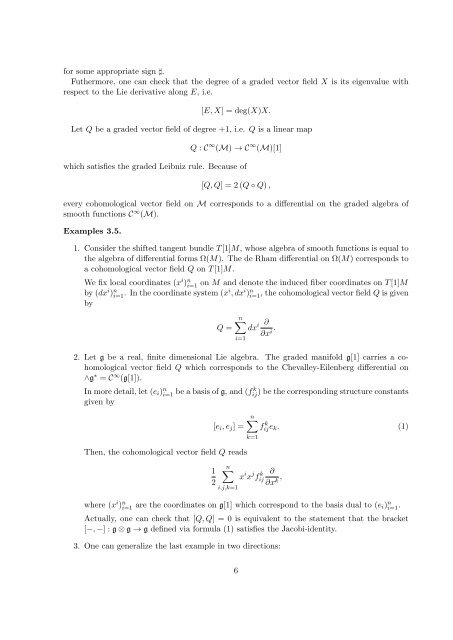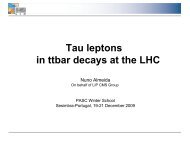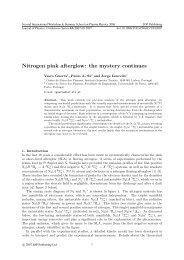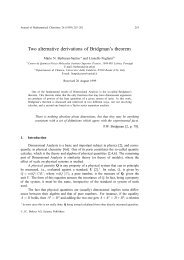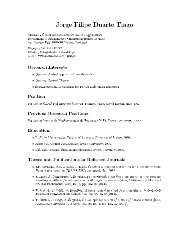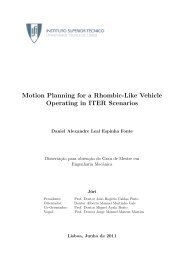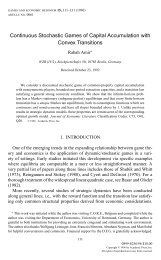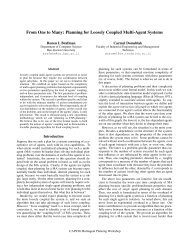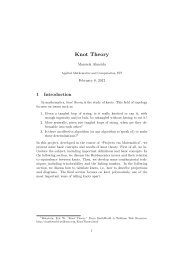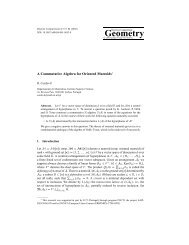Introduction to supergeometry
Introduction to supergeometry
Introduction to supergeometry
Create successful ePaper yourself
Turn your PDF publications into a flip-book with our unique Google optimized e-Paper software.
for some appropriate sign ♯.<br />
Futhermore, one can check that the degree of a graded vec<strong>to</strong>r field X is its eigenvalue with<br />
respect <strong>to</strong> the Lie derivative along E, i.e.<br />
[E, X] = deg(X)X.<br />
Let Q be a graded vec<strong>to</strong>r field of degree +1, i.e. Q is a linear map<br />
Q : C ∞ (M) → C ∞ (M)[1]<br />
which satisfies the graded Leibniz rule. Because of<br />
[Q, Q] = 2 (Q ◦ Q) ,<br />
every cohomological vec<strong>to</strong>r field on M corresponds <strong>to</strong> a differential on the graded algebra of<br />
smooth functions C ∞ (M).<br />
Examples 3.5.<br />
1. Consider the shifted tangent bundle T [1]M, whose algebra of smooth functions is equal <strong>to</strong><br />
the algebra of differential forms Ω(M). The de Rham differential on Ω(M) corresponds <strong>to</strong><br />
a cohomological vec<strong>to</strong>r field Q on T [1]M.<br />
We fix local coordinates (x i ) n i=1 on M and denote the induced fiber coordinates on T [1]M<br />
by (dx i ) n i=1 . In the coordinate system (xi , dx i ) n i=1 , the cohomological vec<strong>to</strong>r field Q is given<br />
by<br />
Q =<br />
n∑<br />
dx i ∂<br />
∂x i .<br />
i=1<br />
2. Let g be a real, finite dimensional Lie algebra. The graded manifold g[1] carries a cohomological<br />
vec<strong>to</strong>r field Q which corresponds <strong>to</strong> the Chevalley-Eilenberg differential on<br />
∧g ∗ = C ∞ (g[1]).<br />
In more detail, let (e i ) n i=1 be a basis of g, and (f ij k ) be the corresponding structure constants<br />
given by<br />
[e i , e j ] =<br />
Then, the cohomological vec<strong>to</strong>r field Q reads<br />
1<br />
2<br />
n∑<br />
i,j,k=1<br />
n∑<br />
fije k k . (1)<br />
k=1<br />
x i x j fij<br />
k ∂<br />
∂x k ,<br />
where (x i ) n i=1 are the coordinates on g[1] which correspond <strong>to</strong> the basis dual <strong>to</strong> (e i) n i=1 .<br />
Actually, one can check that [Q, Q] = 0 is equivalent <strong>to</strong> the statement that the bracket<br />
[−, −] : g ⊗ g → g defined via formula (1) satisfies the Jacobi-identity.<br />
3. One can generalize the last example in two directions:<br />
6


